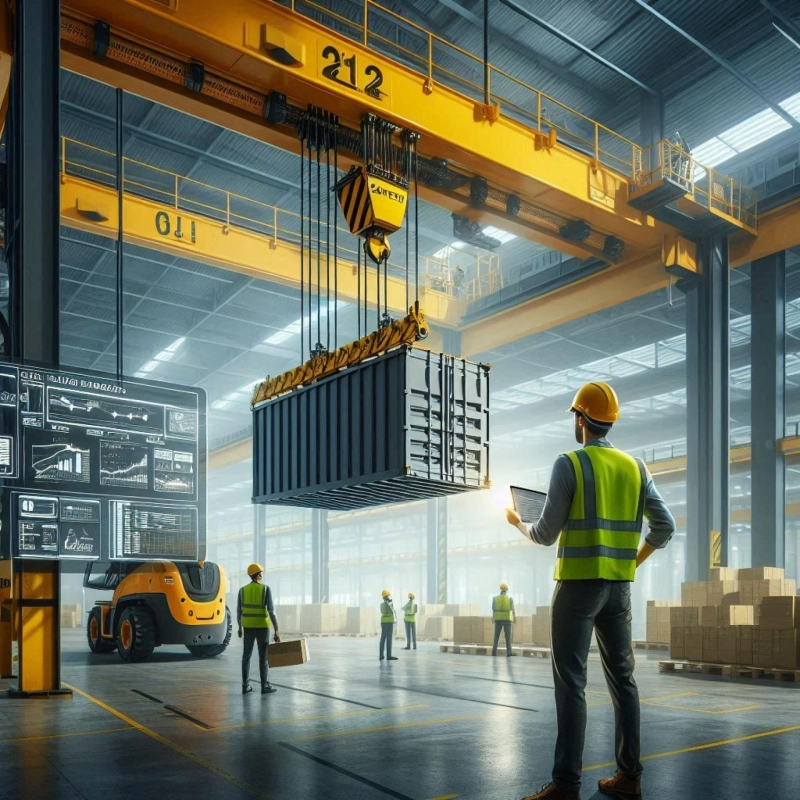Operating overhead cranes is crucial in many industries, from manufacturing to construction. These powerful machines can lift heavy loads with ease, making work faster and safer. However, without proper knowledge and care, they can also pose significant risks. In this blog post, we will explore how to maximize safety and efficiency with overhead cranes. Whether you're an operator, safety manager, or factory owner, this guide offers valuable insights and tips.
Understanding Overhead Cranes
Overhead cranes are essential in many workplaces. They consist of parallel runways with a traveling bridge spanning the gap. A hoist, the lifting component, travels along the bridge. Overhead cranes are used to move heavy objects horizontally within a facility. Their design allows for efficient and safe lifting, reducing manual labor and the risk of injury.
Types of Overhead Cranes
Several types of overhead cranes exist, each suited for different tasks. The most common include:
Bridge Cranes: These cranes have a horizontal beam that moves along two tracks. They are perfect for lifting loads in a specific area.Gantry Cranes: Similar to bridge cranes, but supported by legs that move on wheels or rails.Jib Cranes: These have a horizontal arm (jib) that supports a moveable hoist.Each type offers unique benefits and challenges. Choosing the right crane depends on your specific needs and facility layout.
Safety First
Safety is paramount when operating overhead cranes. Mishandling these machines can lead to severe accidents. To ensure safety, follow these guidelines:
Regular Inspections: Inspect cranes daily before use. Check for any signs of wear or damage.Proper Training: Ensure all operators are adequately trained. They should understand how to use the crane and recognize potential hazards.Load Limits: Never exceed the crane's load capacity. Overloading can cause the crane to fail.Implementing these safety measures can prevent accidents and ensure smooth operations.
Efficient Operation Techniques
Efficiency is about more than just speed. It's about performing tasks correctly and safely. Here are some tips to maximize efficiency with overhead cranes:
Plan Ahead: Before lifting, plan the entire process. Know the weight of the load and the path the crane will take.Clear Pathways: Ensure the area is free from obstructions. This prevents accidents and allows for smooth movement.Use Proper Rigging: Secure the load correctly using appropriate rigging techniques. This prevents the load from shifting or falling during transport.Following these tips will help you complete tasks efficiently without compromising safety.
Regular Maintenance
Maintenance is critical for the longevity and performance of overhead cranes. Regular checks and servicing can prevent breakdowns and costly repairs. Here's what to focus on:
Lubrication: Keep all moving parts well-lubricated. This reduces friction and wear.Component Checks: Regularly inspect components like hoists, chains, and hooks for wear and tear.Electrical Systems: Ensure all electrical systems are functioning correctly. Faulty wiring can lead to malfunctions or accidents.A well-maintained crane is more reliable and safer to operate.
The Role of Technology
Technology plays a significant role in enhancing crane operations. Modern overhead cranes come equipped with advanced features like:
Automation: Automated systems can control the crane's movements, reducing human error.Remote Control: Operators can control the crane from a safe distance, enhancing safety.Monitoring Systems: These systems provide real-time data on crane performance, helping identify issues before they become serious.Leveraging technology can make crane operations safer and more efficient.
Legal Requirements and Standards
Adhering to legal requirements and industry standards is crucial. These regulations ensure the safety and efficiency of crane operations. Key standards include:
OSHA Guidelines: The Occupational Safety and Health Administration provides comprehensive guidelines for crane operation.ANSI Standards: The American National Standards Institute offers standards for crane safety and maintenance.ISO Certifications: International Organization for Standardization certifications ensure that your operations meet global standards.Compliance with these standards is not only a legal requirement but also a best practice for safety.
Training Programs
Proper training is the foundation of safe crane operations. Effective training programs should cover:
Basic Operations: Understanding how to operate the crane safely and efficiently.Safety Protocols: Learning to recognize and mitigate potential hazards.Emergency Procedures: Knowing what to do in case of an emergency.Investing in training ensures that operators are well-prepared to handle the crane safely.
Common Challenges and Solutions
Operating overhead cranes comes with its own set of challenges. Some common issues include:
Load Stability: Ensuring the load remains stable during transport.Operator Fatigue: Long hours can lead to fatigue, increasing the risk of accidents.Environmental Conditions: Adverse weather can affect crane operations.Addressing these challenges involves proper planning, regular breaks for operators, and adapting to weather conditions.
Case Study: Successful Implementation
Let's take a look at a real-world example. A manufacturing plant faced frequent delays due to inefficient crane operations. By implementing the following changes, they saw significant improvements:
Upgraded Equipment: They invested in modern cranes with advanced features.Enhanced Training: All operators underwent rigorous training programs.Regular Maintenance: A strict maintenance schedule was established.These changes led to a 30% increase in productivity and a significant reduction in accidents.
Community and Support
Joining a community of professionals can provide valuable insights and support. Consider participating in:
Industry Forums: Online forums where you can discuss challenges and share solutions.Professional Associations: Organizations like the Crane Manufacturers Association of America offer resources and networking opportunities.Workshops and Seminars: Attending these events can provide the latest information and best practices.Being part of a community helps you stay updated and connected.
Future Trends
The world of overhead cranes is continually evolving. Some future trends to watch include:
AI Integration: Artificial intelligence can enhance automation and predictive maintenance.Sustainability: Eco-friendly practices and materials are becoming more prevalent.Enhanced Safety Features: New technologies are improving safety, such as collision avoidance systems.Staying ahead of these trends can give your operations a competitive edge.
Making the Right Choice
Choosing the right crane for your needs is crucial. Consider the following factors:
Load Capacity: Ensure the crane can handle your heaviest loads.Facility Layout: The crane should fit seamlessly into your existing layout.Budget: Balance cost with the features and capabilities you need.Making an informed choice ensures optimal performance and safety.
Conclusion
Maximizing safety and efficiency with overhead cranes is essential for any industry that relies on heavy lifting. By understanding the different types of cranes, adhering to safety protocols, and leveraging modern technology, you can optimize your operations. Regular maintenance, proper training, and staying connected with the community further enhance your capabilities.
Investing in these practices not only improves productivity but also ensures the well-being of your team. For more insights and personalized advice, consider reaching out to experts in the field.
Ready to elevate your crane operations? Start implementing these tips today and see the difference!


